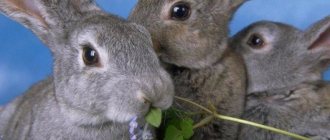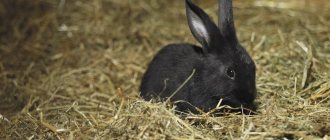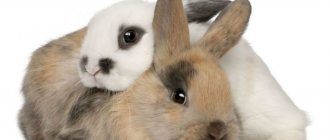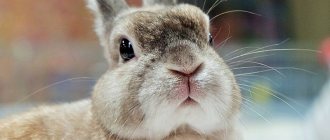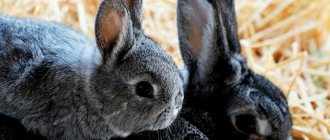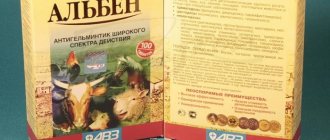Breeding rabbits is a labor-intensive process. But so that all efforts are not in vain, and rabbits grow and always remain healthy, they need to be fed properly. A large part of a rabbit's diet consists of grains. But this does not mean that they can simply replace all feed. Only rational introduction of the right amount of suitable grain can benefit animals.
The benefits of grain crops for animals
Rabbits can be fed wheat, barley, oats, corn, the main thing is to do it correctly and for the benefit of the animal’s health.
Cereals are a basic product in the diet of rabbits, but not all grain crops are well absorbed by the pet’s body.
Rabbits can be fed wheat, barley, oats, corn, the main thing is to do it correctly and for the benefit of the animal’s health.
Combination of wheat with other feeds
As has already become known, it is impossible to feed rabbits only wheat, so it is combined with other grain feeds.
If the grains are crushed or ground, they are added to mixed feed, green grass, potatoes and other vegetables. You can make a grain mixture with the following crops:
- Corn is high in carbohydrates, calcium, protein and fat. It is considered very healthy, but it is added to food in small quantities, as the culture leads to obesity. Before adding to the mixture, you need to separate each grain from the cob.
- Barley is especially beneficial for the digestive system of rodents. It normalizes the functionality of the gastrointestinal tract, eliminates constipation and promotes weight gain. It is important to grind the grains before consumption because they are coated with a film.
- Oats are rich in pantothenic acid, which is necessary for the production of offspring. The crop is considered high-calorie, but despite this, rabbits do not gain excess weight.
See also Nettle in a rabbit's diet: benefit or harm?
To ensure that your diet is as balanced as possible, follow this scheme for combining grain crops:
| Cereals (% of total mixture) | Wheat | Barley | Oats | Corn | Bran |
| Baby rabbits | 10 | 15 | 30 | 30 | 15 |
| Adults | 20 | 20 | 40 | 10 | 10 |
| Meat breeds (for fattening) | 20 | 40 | 15 | 15 | 10 |
Wheat is a valuable concentrated fodder that rabbits need, but in a certain dosage. Don’t forget, in addition to food mixtures, to provide your long-eared pets with adequate nutrition, add branches, plants, vegetables and fruits to their diet every day.
Is it possible to feed rabbits wheat?
Rabbits can and should be given wheat.
This grain contains fats, proteins, carbohydrates, and vitamins. Wheat contains abrasive particles that help prevent overgrowth of teeth in rabbits. The presence of this grain in the diet helps prevent diseases such as malocclusion, which causes many health problems in animals.
Feed wheat contains a lot of vitamin B, and it is recommended to use it as feed.
Your pet's diet should not include only wheat or mixtures in which half of this grain predominates.
Wheat contains a lot of gluten, which can cause:
- bloating;
- excessive gas formation;
- failure of mineral balance.
It is better to feed rabbits grains in a correctly selected consistency - 25% wheat plus other grains.
Rabbits can and should be given wheat
Grain feeders
How much your pet eats depends on the right food supplies. Beginners often use factory-made ceramic bowls for feeding, which the animals turn over. Experienced livestock breeders prefer to make their own containers.
When feeding grain and mixed feed, bunker feeders are most often used. The design is assembled in such a way as to prevent livestock from scattering and trampling food. Food is poured into boxes for several days without thinking about supplements.
Canned food cans can be used for both bulk food and water. The compact and economical option is quickly mounted in the cage and does not cause any inconvenience to the pet. It must be remembered that the sizes may not be suitable for large individuals.
A simple feeder in the form of a trough will be convenient for feeding cereals and mixed feed. Due to its length, access to food is open to all residents of the enclosure. To prevent animals from turning the product over, it is important to make reliable fastenings.
Feeding rabbits grain is a cheaper and proven way to raise animals. Our recommendations will help you find the optimal diet for animals. Simple techniques are time-tested.
How to feed?
For rabbits, wheat is an integral part of proper nutrition. Pets eat raw, steamed and sprouted grains. The owner must select the appropriate feeding method, based on the age and sex of the animal.
Raw
30% of raw wheat is mixed with feed and other grain crops. For lactating and pregnant rabbits, as well as pets that are gaining weight, the specified rate is increased.
Young rabbits have a digestive system that is not yet strong enough, so wheat is introduced into complementary foods gradually. During this period, it is better to feed crushed or bran grains, mixing them with grass and vegetables. Potatoes are ideal among vegetable products.
Be sure to read:
How and what to feed small rabbits per week, 2 weeks, 20 days, 1 month without a rabbit
Steamed
The rabbit's body absorbs steamed whole or crushed wheat well.
To prepare the feed you need:
- 1 kg of grain;
- 2 liters of hot water;
- 1 tbsp. l. salt.
The ingredients are mixed and covered with a lid. After 5 hours, the mixture is ready for use.
To improve the appetite and health of pets, enzymes and vitamins are added.
For this purpose, the wheat yeast method is used. 2% baker's yeast is added to the finished mixture. The preparation is thoroughly mixed and infused for 6-7 hours. The food is suitable for gaining weight in rabbits for meat.
Sprouted
Wheat sprouts contain many useful substances that improve the appearance, functioning of the body, and increase the rabbit’s immunity.
Sprouted wheat must be added to the food of females and males before mating, so that their desire for procreation awakens, and then they get strong and healthy offspring.
Cooking methods
You can prepare grain for feeding rabbits using several methods: steaming, yeasting, germination, crushing.
Before you start cooking, be sure to inspect the grains used:
- The grains should not contain dirty seeds, small stones and green unripe grains. You also need to pay attention to the presence of small insects or fungal spores; they should not get into the food of rabbits.
- If black spots are visible on the grains, they should not be used to feed animals.
- Do not feed overdried or raw grain to rabbits.
IMPORTANT! Experienced breeders use one-year-old grains. You should avoid purchasing crops that can be stored for a longer period.
Cereals must be steamed before serving to rabbits.
Steaming
Steaming is the simplest and at the same time very effective way of preparing grain crops for feeding rabbits.
For steaming, take grains of one type or pour the prepared mixture of cereals into a bucket or other container, but not to the very edge, since during the steaming process the volume of the resulting mass will increase. The grain is poured with boiling water. You need to add 1 tbsp to the water. salt, then stir the mixture and cover lightly with a lid. The container should be left in this form for 5 hours. During this time, the grains will swell and can be used for feeding.
Steamed grains become soft and sweet, the digestive system of animals copes better with such food, and nutrients are absorbed faster. Rabbits eat this food with pleasure.
IMPORTANT! It is highly undesirable to feed rabbits rice and boiled porridge. Also, the animals’ diet should not contain bread or other sweet products. These products cause fermentation processes in the intestines and bloating.
Yeasting
This method of preparing feed is used to accelerate the growth rate of animals and rapid weight gain. It can be used for rabbits starting from 4 months of age. Preparation proceeds as follows:
- The grains are ground and mixed in a container with water in a ratio of 1:2.
- Yeast is diluted in water at the rate of 36 g per 2 liters of water.
- All components are thoroughly mixed and left overnight.
- The whole process takes about 6-9 hours. From time to time the mass needs to be stirred.
When feeding, add 2-3 tablespoons of yeast mixture to the dry cereal mixture at each meal. This regime is maintained for 5 days, after which the food is changed.
Sprouted grains are much healthier than dry grains
Germination
Sprouted grains are much healthier than dry grains due to the fact that during the germination process they release beneficial substances that are not absorbed by the body when dry grains are consumed. Swollen fiber perfectly cleanses the animal’s intestines, removing accumulated waste products from the body, and also increases the body’s protective functions.
When preparing food, you need to pay attention to the following points:
- The grains selected for cooking should be pre-washed in warm water. If you immerse grains in water, you will notice that some of them float to the surface. Such grains cannot be used as food for rabbits; they are already considered dead.
- The grains should be washed several times to prevent fungal spores from getting into the feed. During the growth of grain crops, enzyme poisons are released that are detrimental to animal health.
- If silver water is used when washing grain, and not ordinary drinking water, then there is no need to repeat the procedure several times.
If food needs to be prepared for a small number of animals, then you can germinate the grains in a plate, placing them in a damp cloth, and you need to regularly add water to the grains to maintain the moisture level. On large farms, feed is prepared in buckets, filling the grains with water up to 2 cm from the edge.
The whole process consists of the following steps:
- The grains filled with water are left for 12 hours, during which time they will swell well.
- After 12 hours, the grains are transferred to plastic bags, in the bottom of which holes should be cut so that all excess moisture is drained from the grains.
- The bags are placed in a warm place. The grain layer should not be higher than 8 cm.
- The mixture can be fed to rabbits when sprouts become visible in it.
IMPORTANT! If the mixture has darkened, it cannot be used for feeding.
Crushed grain
Another method of preparing feed is crushing. You can purchase the cereal mixture in this form, or you can prepare it yourself. To do this, you just need to grind the prepared culture. Typically, corn is crushed, but oats, wheat or barley can also be prepared this way.
How to germinate wheat for rabbits?
Wheat sprouts contain many useful substances that improve the appearance, functioning of the body, and increase the rabbit's immunity.
There are 2 ways to sprout wheat. The first is suitable for a small number of pets, the second - for a large household.
1st method
To obtain shoots, wheat is soaked in water and left for a day in a warm room. When the grain swells, it should be spread in a thin layer into a container (baking tray, tray), covered with a wet cloth, and left warm until germination.
2nd method
A significant volume of grain is filled with water. The container is left in a cool place for 12 hours. The swollen wheat is transferred to plastic bags with holes to remove excess moisture. For sprouts to germinate, the bags must be kept in a warm room.
Rabbits must be fed sprouted wheat, the sprouts of which do not exceed 1.5 mm.
Rabbit breeders should carefully monitor the germination process. Sprouts that reach 2 mm in length do not carry much nutritional value, and toxic substances are formed in large sprouts.
Cleanliness is the key to a healthy pet. The cage and food must be kept clean at all times.
Germination
Millet is not usually given to rabbits in its natural form. The grains can be ground and sprinkled on other foods, such as root vegetables. Millet seed is also brewed or steamed. This paste can be added to mash.
Sprouted grain is given to rabbits without additional processing. Barley and corn need to be crushed and steamed for better absorption. But wheat grains and oats can be fed without additional processing, since they are quite soft.
If any of these crops are sprouted, then for rabbits it will be another source of vitamins. When there are few rabbits, cereals for germination are placed in a wet cloth. Humidity must be maintained until sprouts appear.
For large-scale farming, grains are placed in large containers, filled with water and left for 12 hours. When the contents swell, they are transferred to cellophane bags for germination (8 cm layer) with holes for draining water. Sometimes you need to shake up the grain. Such food is introduced gradually; in large quantities it causes bloating. If the grain has darkened during sprouting, it is not suitable for feeding rabbits.
What else can you feed rabbits using grains?
Rabbits can be given barley, oats and corn. Each culture has its own characteristics.
Be sure to read:
Is it possible to feed rabbits with watermelon rinds, especially decorative ones? Do they even eat the rinds?
Oats
Oats are considered a dietary grain. It can be present in the total mass of feed up to 50%. Oats contain pantothenic acid, which keeps your pet's body in good shape and develops reproductive function.
You need to buy oats for rabbits in a specialized store.
The livestock breeder must pay special attention to the quality of the product, based on the following criteria:
- dry grain;
- no mold smell;
- a small amount of husk.
Failure to comply with the purchase rules will lead to problems in the pet’s digestive system.
Barley
Barley is much more nutritious than oats. To prevent obesity in pets, you should control the amount of grain in the diet.
Despite the calorie content of the product, young individuals and lactating females are fed barley to gain weight. The grain contains important animal amino acids that promote good digestion.
There is one drawback to barley - a poorly digestible shell in the form of foam. To avoid digestive difficulties in animals, it is necessary to grind the grains.
Corn
Cereal is considered a high-energy food. Animals are content with the cobs, stems, and leaves of the plant.
Corn is considered a high energy feed
Corn contains enough carotene, carbohydrates and vitamin E, but not enough protein and calcium, which is why it is not recommended to feed rabbits exclusively with corn.
It must be mixed with other grains in the correct proportions, then pets will not gain excess weight.
Main components of grain mixtures. Corn.
Advantages.
- Balanced composition (optimal growth and maintenance of reproductive functions).
- Convenience of feeding. Only water granules.
- Ease of transportation and storage.
- Availability of growth accelerators (proteins, premixes, yeast, vitamins)
- Stable diet and absence of digestive disorders.
- Minimal risk of harmful inclusions.
- Easily eaten, little waste.
- Does not lead to obesity in breeding individuals.
- Gradation of compound feeds according to different categories (for young animals, for adults, for lactating animals, fattening)
- Possibility to contact the manufacturer to clarify current issues.
Flaws.
- Expensive.
- Not sold everywhere, rural areas are especially affected.
- Possible counterfeit.
- Possible addition of substandard components (mucoid enteritis).
- Habituation of rabbits and associated risks of disorders when changing brands or batches of food.
- You need several types of feed for different categories of rabbits.
Advantages.
- Cheaper than feed, especially in rural areas.
- Availability of purchase.
- Natural, natural taste of meat.
- Visual control of the composition.
- The ability to change the composition of the mixture yourself for different categories of rabbits.
Flaws.
- Growth is slower than when fed with compound feed.
- The need to grind grain (corn, wheat) for small rabbits.
- The need to prepare and store hay.
- The need to steam the crushed grain mixture.
- Risks of grain contamination on threshing floors.
- Large losses due to trampling.
Barley is considered the most versatile. Thanks to a unique set of nutritional components, it is suitable for all categories of rabbits: babies and adults, pregnant and lactating females. If you feed only one grain, then it is best to stop at barley. It is eaten with great appetite and does not create digestive problems even with constant access to food.
Wheat is just as versatile, even more high in calories. Although this may be a disadvantage. More precisely, rabbits, when fed uncontrolledly, overeat and gain fat. For fatteners it may not be bad, but for others it’s a big problem with reproduction. In addition, overeating wheat grains can cause bloating.
Oats, as the opposite of wheat, are easily digested, improve digestion, and do not cause obesity. Very useful for breeding rabbits, increasing reproductive functions. However, it is inferior in calorie content. For the normal development of the animals, it is necessary to mix other grains with barley or alternate with it.
Peas are rich in proteins and fats, but are difficult to digest. Under-dried beans can cause upset. But, if given correctly, the benefits are enormous. Indicated for females, as it improves lactation (milk production) and supplies building material for the formation of embryos. The young animals are gaining weight well. It is best to steam crushed peas (as part of a grain mixture, mash, or even separately).
Feeding according to the Zolotukhin method
Zolotukhin’s methods have already helped many rabbit breeders achieve the desired results.
The peculiarity of the idea is to feed pets with soaked and dry grain:
- Whole, dry oats are best given to females that will not breed.
- Crushed barley grains are given to female rabbits before mating and giving birth.
- For older individuals who have begun to feed on their own, steamed oats are added.
- Animals over 4 months of age must be fed crushed corn.
- The grain mixture for mature individuals includes oats, barley, and a small amount of corn. Eating such grains increases reproductive function.
The technique allows you to reduce the incidence of illness in pets and ensure rapid weight gain.
Differences in feeding in winter
In winter, a rabbit's diet should contain many vitamins. Fish oil is used as a supplement.
Be sure to read:
What grass do rabbits like and eat, what grass should they not be given, how much hay do they need
One individual needs:
- 0.5 g – for rabbits;
- 1 g – adult pets;
- 2 g – to pregnant females;
- 3 g – lactating rabbits.
Rabbits are fed sprouted grain or wheat with baker's yeast. The yeast method should be alternated 5 through 3.
In summer, owners must stock up on hay; in winter, it makes up almost half of the animals’ diet. To feed juicy food, carrots, turnips, cabbage, and dry grass are fermented in barrels.
Your pet's winter diet should be varied and balanced, since at this time there is a shortage of additional proteins, fats, and carbohydrates.
There is no need to increase protein value. The animal body is able to receive and digest the required amount of the substance at any time.
On a note! Feeding should always be done at the same hours 2-3 times a day. If the food is warm, your pet's digestion and appetite will improve.
DIY greens
To diversify the diet of livestock, professionals use fresh grass. But what can you do in winter when you don't have access to an important element of your diet? In this case, it is better to grow tasty food from grain.
The hydroponics method allows you to obtain juicy greens from cereals. The first step is to disinfect the raw materials using a quartz lamp. Radiation kills fungi and diseases that may be on the surface of the crop. Then pour it into a container, fill it with water and leave it in a cool room for a day to swell.
The finished material is laid out on pallets with sides. It should be remembered that the layer should not exceed 2 cm, otherwise there will be a problem with pecking. Cover the top with a rough cloth and spray with water from a spray bottle. The containers are left for 3 days at a temperature of 24°C. To prevent drying out, the burlap is irrigated with liquid once a day.
The sprouted grain is moved closer to natural light. For a week, water with a special hydroponic solution:
- water - 20 l;
- wood ash - 1 kg;
- ammonium nitrate - 200 g;
- boric acid - 0.7 g;
- copper sulfate - 0.01 g;
- manganese sulfate - 0.4 g.
The liquid is mixed with ash, boiled and filtered through thick gauze. Then the remaining chemicals are added, thoroughly dissolved and packaged in glass jars. For one bucket of water you need 200 ml of solution. This substance is watered over cereals twice a day. From one pallet you can grow enough greens for your entire livestock
How much grain does a rabbit need per day?
A young animal will need 30-40 g of feed per day.
For one adult in the summer, 50 g of grain per day is enough. In winter, the norm increases to 60 g.
When pets are prepared for mating, they need 80 g of grain in the warm season, and 100 g in the cold season.
A pregnant rabbit eats 70-90 g of grain in summer, 100-130 g in winter. For a lactating female, the daily norm increases to 150-160 g.
Important! Feeding dry grain should be combined with sufficient water. Pets need fresh water morning and evening.
Harm and contraindications
There are many benefits from feeding rabbits with wheat food: the animals get full and quickly gain weight. In addition, grain is not so expensive; it can be bought whole or immediately crushed. Labor costs are also reduced: the feed is simply poured into the animals’ feeders. True, in addition to the unconditional advantage of dry feeding, this method has several disadvantages and unpleasant moments.
The fact is that sometimes animals are allergic to wheat feed. The animals' bodies simply cannot tolerate such food. True, this happens extremely rarely. However, before you pour grain into the feeder, you must first see how the animal reacts to this cereal crop. To begin with, the animals are given 10-20 grains. If the rabbits do not diarrhea, they do not have bloating, or foam at the mouth, then wheat will benefit them. Otherwise, it is better to exclude this cereal from animal nutrition.
If you feed rabbits only wheat, they will quickly gain weight and gain weight. The consumption of such grain feed also needs to be dosed because a large amount of grains can lead to bloating. To avoid eating disorders, livestock specialists recommend mixing wheat with other grains and giving no more than 10-30 grams of this crop per day.
Important! It must be remembered that the rate of any cereal per day depends on the age of the animal and its well-being. If there is an excess or deficiency of wheat in the diet, then rabbits can get sick. Animals in a state of physiological rest need no more than 10 grams of wheat feed per day. For pregnant rabbits, the dose can be increased to 35 grams. In winter, grain feed is always given more than in summer.

